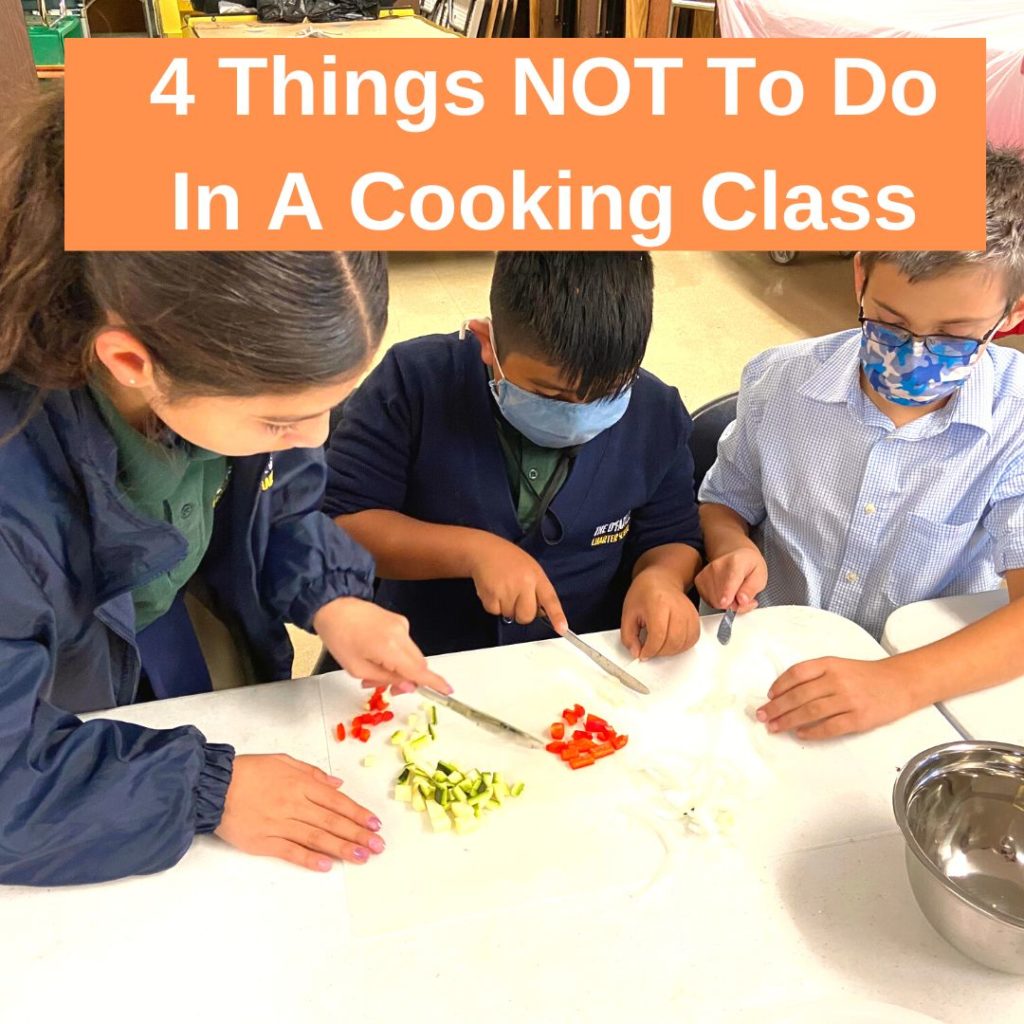
After teaching healthy culinary workshops for over 13 years, here are some key things to NOT do in a cooking class.
A cooking class is a unique experience because there are a lot of moving parts.
You have
- Kids
- Cutlery
- Graters
- Skillets
- Knives
- The distractions of being at a school
- Fresh ingredients
- Time constraints
And more!
- Do NOT let kids use sharp knives
I’ve had clients ask if we could use paring knives or even small chef knives with students and we always say we can’t. A group cooking class with 10-20 students is not a good environment to show kids how to hold and safely chop using an 8″ chef blade…especially if those students are in elementary school.
This is why we prefer to use metal dinner knives (aka butter knives). They are very mildly serrated and it’s virtually impossible to cut yourselves with them (and I’m thankful to say that no one has hurt themselves with them over the last 13 years).
Our Chef Teachers will pre-chop zucchini, carrots, bell peppers and more into strips so that students can chop them into small, bite-size pieces. They love chopping and it’s always a highlight of the class.
- Do NOT under (or over) cook your food!
Cooking requires a skillset so you know when things are done. Sauteed veggies can go from “nicely browned” to “burnt” very quickly if you’re not paying attention. When you’re cooking chicken you have to make sure it’s fully cooked (aka white in the middle) before serving it, otherwise it could be dangerous to eat.
Our Chef Teachers have tutorials and instructions for all of our recipes to ensure everything is cooked well. You have to know how to cook things to the correct temperature, and it’s also a good thing to teach kids so they can cook correctly at home.
- Do NOT let kids be active and move around
We have a saying in our workshop training for our staff that “seated kids are happy kids.” We don’t want kids running or moving around. If clients offer us to cook in their kitchen, we actually decline the offer and propose working in a place with tables and chairs for kids to sit. This might seem counte interuitive, because whether you’re cooking at a restaurant or at home, you always will see chefs and homecooks standing. It’s easier to chop and move about that way.
But when you have a class of 16 2nd and 3rd graders, you want those kids stationary! We situate our students on a long table with the Chef Teacher in the middle. We use class management techniques like the Counting Technique and the Clap Technique to maintain focus when needed.
They get to chop (as I discussed previously) and then when it’s time to cook, they come up in small groups of 5 to do one action in front of the skillet like adding salt or stirring the dish. Meanwhile, the rest of the kids are sitting and watching what’s going on.
- Do NOT be boring when teaching kids cooking
Excitement is a key ingredient in our lessons. Students look forward to the culinary workshops as part of their after-school or summer program. We select instructors who are happy, outgoing and enjoy teaching kids so the class is a joy to experience.
One of our 6 core values is “Bring The Fun” and this applies to everything that we do, especially recruiting out Chef Teachers.
No matter how good the lesson and recipe is, if the instructor isn’t engaging, the class will not be memorable. I know that when I personally teach in front of kids, I get extra energy and I turn on my “teaching mode” to make sure the class is a hit for the kids.
And those are some key points to a successful cooking class!
If you missed our previous email about the invite to our VIP Client Appreciation Dinner at Beyond School Hours, CCSA and/or BOOST. Click here to get the invite details if you’re a current client or a qualified prospect.
And if you’d like to bring to bring healthy culinary workshops to your school where we use knives effectively, cook foods safely, make sure kids are seated and “bring the fun” book a meeting with me here
Previous Newsletters
Our Best Lessons For New Clients
5 Reasons Why We Are Working with Grant-Based Clients This Fall
Client Case Study: Pomona USD How We Taught 110 Hours of Culinary Workshops
Best,
Eric Horwitz